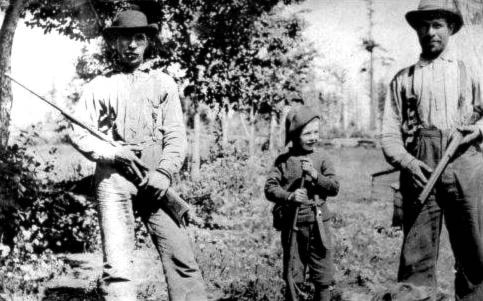Not a scene we see much nowadays, but typical of the region in the 1920s when this photo was taken, the picture shows hunters Frank and Joe Caffery with their weapons, and little Johnny Walker, thrilled to be included.
Our gun aficionados identify Joe Caffery’s gun as a 30-30 Winchester and little Johnny’s as a Winchester 22 single shot. Note the little guyis also equipped with a knife and scabbard.
The Cafferys and their cousins, the Brown family, were early East Sooke residents. Last week, Historical Society board member Dr. David Lintern, museum staff member Montana Stanley and I had the pleasure of a tour of historic spots of East Sooke with the guidance of longtime citizen Louise Paterson, a Brown family descendant.
Besides stopping at the site of the old pioneer schoolhouses and the location of the long-gone Farmers’ Institute Hall, built with the financial help of Lady Emily Walker, we stopped at historic Ragley, once home to Lady Emily and her family, to chat with Rob Hill. We also stopped where the Cafferys had an oyster farm right close to Ragley, at Anderson Cove, handy for visiting back and forth.
Back in those days, local people mainly lived off the land, with hunting, fishing and subsistence farming the general way of life. Besides fish and shellfish, deer and grouse were mainstays of the larder. While sheep farming was typical in the area, where lambs were supplied to city markets, it was often a contest between the cougar and the farmer.
The Cafferys are a family with a longstanding impact on the community; the popular name for Anderson Cove was Caffery Bay. It is our understanding that Frank Caffery, on the left, was actually the father of little Johnny Walker. Not surprisingly, the teenaged Margaret Walker, only daughter of British nobility’s Lady Emily Walker, had become enamoured of the neighbor, Frank Caffery, and this little fellow was the result.
Lady Emily took pains to raise the child in her own household as a Walker, and in time, when her daughter Margaret was older she and Frank Caffery were married and lived a happy life together. Many Sooke folk will remember Kay (Caffery) Jeffrey who was born later to Frank and Margaret Caffery; Kay was the source of our family information.
Sadly, littlest hunter Johnny Walker, a pilot in World War II, was shot down flying his Spitfire over the English Channel strafing radar sites. Among the descendants he left, though, is Anne (Woolley) Gibson, who has lived most of her life at West Coast Road in Sooke.
•••
Elida Peers is the historian of Sooke Region Museum.
editor@sookenewsmirror.com
Like us on Facebook and follow us on Twitter
